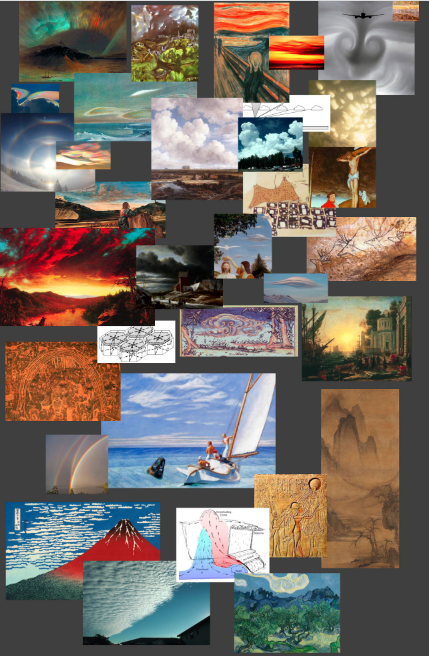The soul of all scenery by Stanley Gedzelman
The Soul of All Scenery: A Deeper Dive into Atmospheric Optics
Atmospheric optics is a captivating field that explores the wonders of the sky, clouds, and their interactions with light. One expert who has delved into this subject with a unique perspective is Stanley Gedzelman, a distinguished meteorologist and atmospheric optics specialist. In his book, "The Soul of All Scenery," Gedzelman takes a novel approach by examining the portrayal of skies in art through the lens of science, offering fresh insights into the way artists throughout history have depicted the celestial realm.
Gedzelman's exploration begins by tracing the depiction of skies in art back to prehistoric times, long before the advent of sophisticated painting techniques. Surprisingly, it appears that early artworks rarely featured detailed representations of the sky. While the Ancient Egyptians had a hieroglyph for "the heavens above," their paintings seldom included clouds, rainbows, or ice halos - all phenomena that surely occurred in their skies. This raises intriguing questions about why these natural elements were neglected in their artistic renderings.
One possible explanation proposed by Gedzelman is that ancient artists may not have fully understood the science behind these atmospheric phenomena. Rather than deliberately omitting them from their works, they may have lacked the knowledge or means to accurately portray clouds or other optical effects. As we consider these ancient artworks, it's fascinating to ponder how the absence of such elements may have shaped our perception of the skies in those times.
However, as time progressed and civilizations advanced, artists began to incorporate more accurate depictions of the sky into their works. Gedzelman's book showcases examples from Greek and Roman periods where clouds and other atmospheric features became more prevalent in paintings. It becomes evident that artists in these eras had a deeper understanding of the natural world and its visual representation.
To highlight this newfound appreciation for atmospheric optics in art, Gedzelman pairs individual artworks with images of comparable skies. This juxtaposition allows readers to see the correlation between the artist's portrayal and the actual atmospheric conditions that may have inspired their work. It is remarkable to discover that many artists throughout history possessed an intuitive understanding of clouds, using them to convey emotion, drama, or even a sense of tranquility in their compositions.
Gedzelman's book provides a scientific lens through which we can appreciate the artistry of these depictions. By explaining the underlying atmospheric phenomena behind these paintings, he enhances our understanding of the artist's intent and the broader cultural context in which these works were created. It invites us to view these masterpieces not only as artistic expressions but also as valuable records of the Earth's ever-changing skies throughout history.
In addition to exploring the historical perspective, Gedzelman's book also serves as a testament to the enduring beauty and fascination of atmospheric optics in contemporary art. By examining modern artworks, he reveals how artists continue to be inspired by the interplay of light, clouds, and the sky. From impressionistic landscapes to abstract interpretations, these works demonstrate that the allure of atmospheric optics persists as a source of inspiration for artists across various genres and styles.
"The Soul of All Scenery" is a captivating journey through the intersection of art and science, offering a deeper understanding of how our perception of the sky has evolved over time. Gedzelman's expertise in meteorology and atmospheric optics, combined with his passion for art, provides readers with a unique perspective on the portrayal of skies throughout history. Whether you are an art enthusiast, a lover of science, or simply curious about the wonders of the natural world, this book promises to captivate and enlighten, revealing the hidden secrets of the soul of all scenery.

The sky, clouds, optics, Art
Download this free book by Stan Gedzelman.
Stan is a distinguished expert in meteorology and atmospheric optics with a profound interest in art. He examines the portrayal of skies from prehistoric cave paintings to modern day through the eyes of science rather than the conventional approaches of art historians. Scientific explanation lace the book and individual artworks are often paired with images of
comparable skies. We find that the artists knew their clouds indeed, they did not daub blobs.
From prehistoric paintings? Stan shows that we can search long and hard for a sky (other than a hard vacuum betwixt sun and earth) in paintings up to perhaps late Greek and Roman
times. For example, Ancient Egyptians had a hieroglyph for 'the heavens above' but not it seems for a cloud, a rainbow nor an ice halo. Their scenes of hunting or luxuriant marsh
life lack clouds. Yet their climate was more humid than now and all certainly occurred in their skies. Stan's reasons for this nephological neglect give pause for thought.


Note: this article has been automatically converted from the old site and may not appear as intended. You can find the original article here.
Reference Atmospheric Optics
If you use any of the definitions, information, or data presented on Atmospheric Optics, please copy the link or reference below to properly credit us as the reference source. Thank you!
-
<a href="https://atoptics.co.uk/blog/the-soul-of-all-scenery-by-stanley-gedzelman/">The soul of all scenery by Stanley Gedzelman</a>
-
"The soul of all scenery by Stanley Gedzelman". Atmospheric Optics. Accessed on November 26, 2024. https://atoptics.co.uk/blog/the-soul-of-all-scenery-by-stanley-gedzelman/.
-
"The soul of all scenery by Stanley Gedzelman". Atmospheric Optics, https://atoptics.co.uk/blog/the-soul-of-all-scenery-by-stanley-gedzelman/. Accessed 26 November, 2024
-
The soul of all scenery by Stanley Gedzelman. Atmospheric Optics. Retrieved from https://atoptics.co.uk/blog/the-soul-of-all-scenery-by-stanley-gedzelman/.